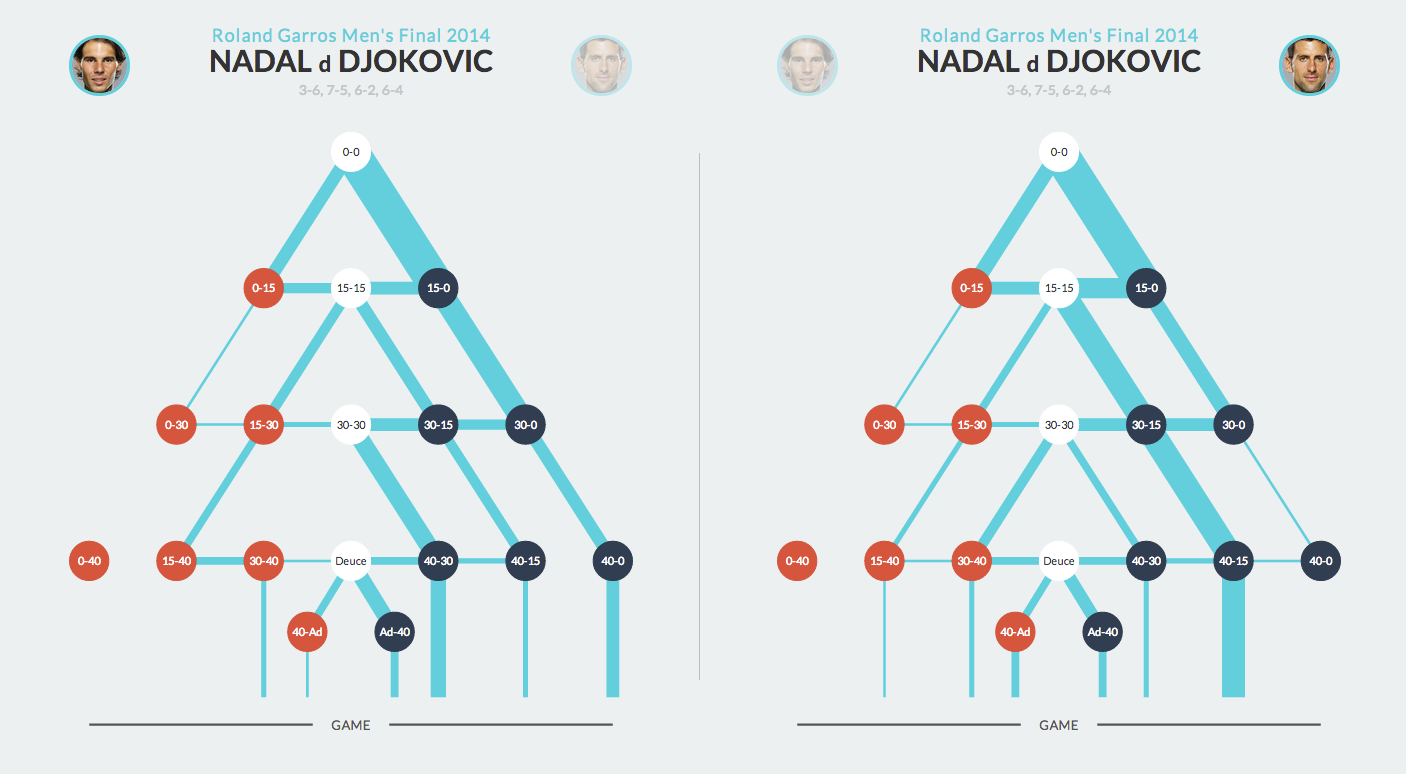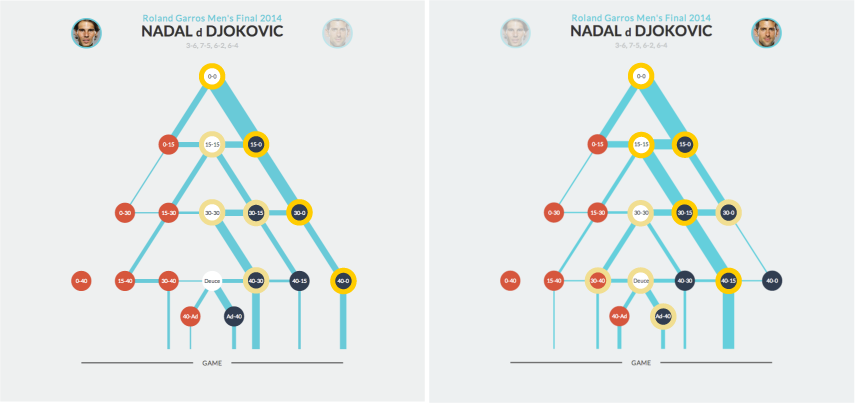Rafael Nadal continued his dominance on court Philippe Chatrier with an emphatic 3-6, 7-5, 6-2, 6-4 win over Novak Djokovic to take out the French Open for an incredible 9th time. Below are Novak and Rafa’s interactive Game Trees. You can explore the interactive game tree here.
Roland Garros Men’s Final 2014 Game Trees (click to enlarge).
How the Game Tree Works
Each point is color-coded to reflect the momentum in each game. A match that is dominated by the server is highlighted with a thicker, outside flow through the ‘positive’ blue points of the Game Tree. More tightly contested service games result in thicker lines through the ‘neutral’ (white) and ‘negative’ (red) points of the Game Tree. You can click on each line to reveal how many times the score passed through that point in the match.
A Summary of the Roland Garros Game Tree
- Nadal won 16 service games. He was broken 3 times.
- Djokovic won 14 service games. He was broken 6 times.
- Nadal won 6 service games from 40-30 (38%), and 5 from 40-0 (31%).
- Djokovic won 9 service games from 40-15 (64%), and 2 from 40-30 (14%).
- Djokovic lost his serve 3 times (50%) from 40-Ad. He lost his serve twice at 30-40 (33%), and once from 15-40 (16%).
- Nadal lost his serve 2 times from 30-40 (67%). The one other time he lost serve was at 40-Ad.
- Nadal won 74% of first points while serving.
- Djokovic won 70% of first points while serving.
- Neither player served out a shocker of a service game (loosing from 0-40). However both players found themselves at 0-30 once, but each time they were able to push the score back to 15-30.
Most Frequently Played Points
Roland Garros Men’s Final Most Frequently played points (click to enlarge).
Nadal played most of his points down the outside positive section of the game tree (as indicated by the rich yellow markers on the above diagram). Other commonly played points by Nadal were played at 15-15, 30-30 and 40-30 (as indicated by the lighter yellow markers).
Djokovic played most of his points down the positive section of the game tree, but with a little less safety than Nadal. Most of Djokovic’s points were played within one point of the neutral section of the game tree, whereas Nadal’s were played within two points of neutral section of the game tree.
The Big Difference: 30-30
The big difference between the two player’s game trees is at 30-30.
Nadal played 30-30 seven times, and was able to convert 100% of those into a very positive position, 40-30 (see below). Djokovic also played 30-30 seven times, but was only able to get to 40-30, 3 times (43%). He was forced into a very dangerous position (30-40) 4 times (57%).
Nadal Djokovic
Conclusion
The Game Tree was originally developed to give us a better understanding of the final score, and how close a match was. It provides one of many ways to analyse the final result of a tennis match. In this match the game trees for each player were remarkably similar hinting that the match was tightly contested. No player likes to see too many (if any) thick lines extending from the bottom four red circles of the game tree like. In this match Djokovic saw his service broken 6 times (once at 15-40, twice at 30-40, and three times at 40-Ad). (Note: lines extending from any of the four bottom red circles means a player lost his serve). Djokovic played 15-15 point better than Nadal, but clearly Nadal played 30-30 far better than Djokovic. Nether player played through deuce a lot (in comparison to other matches). However, Nadal was able to convert more winning games from deuce than Djokovic. Nadal converted 75% of games played through Deuce, while Djokovic converted only 50% of games played through deuce. At 40-30, Nadal also had a better conversion rate than Djokovic (66% to 40%).
Like we see in so many of these matches, games are won and lost at a few very important points. The game tree suggest there wasn’t much in this match between these two players. It does however suggest that Nadal was perhaps the better ‘big point’ player, and as we know in tennis, big points win matches.
Make your own conclusion about the final using the interactive Game Tree here.
@damiensaunder



